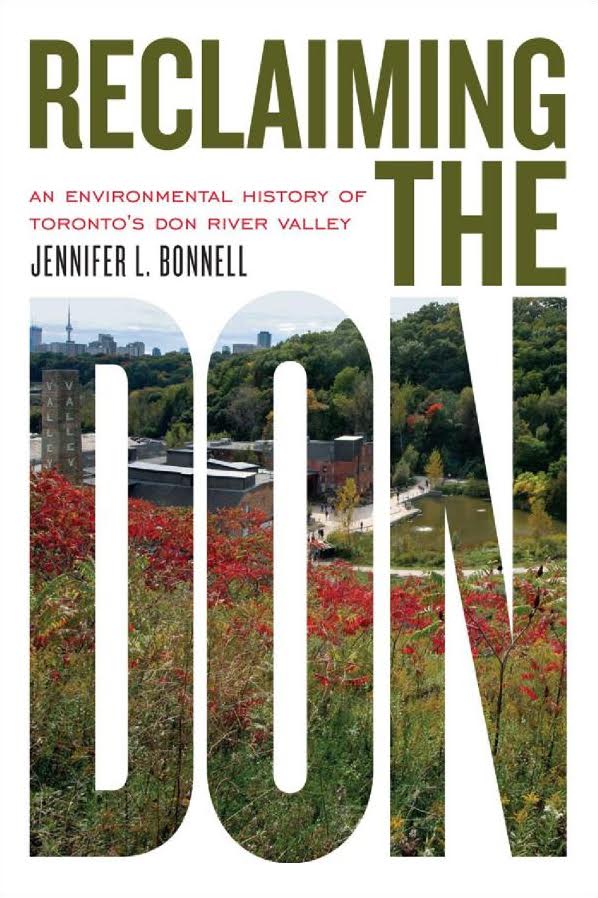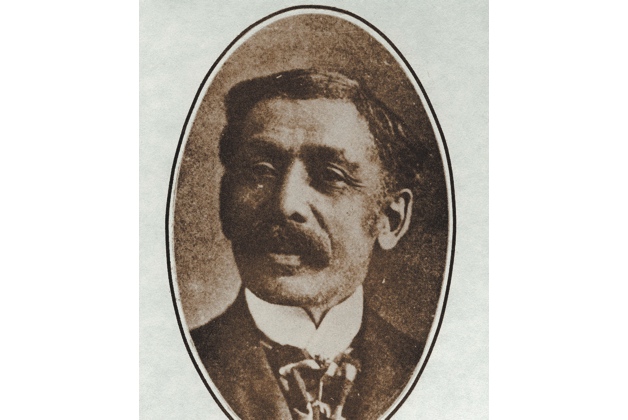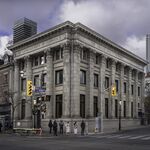Following the recent announcement of nominees for Heritage Toronto's William Greer Architectural Conservation and Craftsmanship Awards, a full list of nominations has now been released for the other categories of the 41st Heritage Toronto Awards. The winning entries from all categories—including Book, Media, Short Publication, and Community Heritage—will be announced at an awards ceremony held at Koerner Hall on the evening of October 13th.
This year's awards will be hosted by the CBC's Mary Ito, while the awards ceremony will also include Heritage Toronto's annual Kilbourn Lecture, this year delivered by Rahul K. Bhardwaj, President and CEO of the Toronto Foundation. The theme of the lecture will be "Building Compassionate Cities," and, together with the award ceremony, the event will honour the recording and preservation of the city's past in a manner that benefits and serves our collective future.
Previewing the awards, UrbanToronto offers you a brief overview of each category—the William Greer Architectural Conservation and Craftsmanship projects were previewed earlier—and its nominees.
This full list of nominees below is interspersed with photos of some of the nominated items. Those pictured were chosen as they represent a range of items, and do not indicate any favouritism on our part, nor any inside track on which projects are likely to be winners.
Book Awards
According to Heritage Toronto, "the Book category recognizes well-written non-fiction books published in 2014 that explore Toronto’s archaeological, built, cultural or natural heritage and history." Nominated works include a wide variety of subjects and styles, ranging from personal memoir, to academic study, to photojournalism.
Michael A. Amos' Both Sides of the Fence: Surviving the Trap, provides a first-hand account of growing up at Jane and Finch, and overcoming the dangers that befall youth in a marginalized neighborhood that seems chronically overlooked by the ostensibly compassionate society around it. Another memoir, Davy the Punk, by Bob Bossin, sees the author explore the mythos of his own father, who was a prominent figure in Toronto's underground gambling scene of the 1930s and 40s.
 Both Sides of the Fence, by Michael A. Amos, image courtesy of michaelaamos.com
Both Sides of the Fence, by Michael A. Amos, image courtesy of michaelaamos.com
Several of the nominated works provide focused studies of the city's history, whether through the lens of neighborhoods, landmarks, public spaces, or environmental features. The Cabbagetown Preservation Association's Adversity, Resilience, Prosperity: The Odyssey of a Canadian Inner-City Neighbourhood. Cabbagetown 1941-2011, provides a detailed study of a historic neighborhood, as does Elizabeth Gillan Muir's Riverdale: East of the Don. Jennifer L. Bonnell's Reclaiming the Don: An Environmental History of Toronto's Don River Valley, meanwhile, provides an environmental history of the river in relation to the city around it.
 Cover of Reclaiming the Don, image courtesy of the University of Toronto Press
Cover of Reclaiming the Don, image courtesy of the University of Toronto Press
Arlene Chan's The Chinese Head Tax and the Anti-Chinese Immigration Policies of the Twentieth Century, aimed at young readers, provides an analysis of Canada's troubled racial history, while Allan Levine's Toronto: Biography of a City compiles four centuries of local history through a series of colourful vignettes.
 Toronto: Biography of a City, by Allan Levine, image courtesy of allanlevincebooks.com
Toronto: Biography of a City, by Allan Levine, image courtesy of allanlevincebooks.com
A number of works explore local history through a highly focused context, such as Francesca Grosso's The History of Sunnybrook Hospital: Battle to Greatness, Jordan St. John's Lost Breweries of Toronto, John Goddard's Inside the Museums: Toronto's Heritage Sites and their Most Prized Objects, and Michael Glassman's Views of the CN Tower, which combines photo-essays with quotes from historical and literary sources.
Short Publication
Nominees in this category are recognized for writing "non-fiction articles and booklets published in 2014 that explore Toronto’s archaeological, built, cultural or natural heritage and history."
Two of the nominated pieces come from Torontoist, exploring voting rights, in Jamie Bradburn's "Voting Rights in Toronto: Who Has (and Hasn't) Been Allowed to Cast a Ballot in Our Elections," and the history of the High Park Mineral Baths, in David Wencer's "Historicist: Swimming at the Minnies."
 William Peyton Hubbard, image courtesy of NOW Magazine
William Peyton Hubbard, image courtesy of NOW Magazine
In NOW Magazine, Marie Wilson's "The Historical Irony of William Peyton Hubbard" (pictured above) sheds light on the remarkable story of Toronto's first black alderman, while, in the Toronto Star, Angus Skene also chronicles a prominent character in Toronto's history in "The Charming Scam Artist Who Built Roncesvalles." Writing for The York Pioneer, Stephanie Lever contextualizes local history through the study of noteworthy individuals, this time the members of the industrialist Edwards family in "Before the Barns: The Edwards Family and Their Leather Factory."
Rounding out the nominations, Ian Radforth—writing for The Canadian Historical Review—analyzes sectarian rioting in 19th century Toronto in the article "Collective Rights, Liberal Discourse, and Public Order: The Clash over Catholic Processions in Mid-Victorian Toronto." Finally, Daniel Ross and Jay Young provide a thought-provoking piece about the creation of a Toronto museum (and the history of such a project) in "An Idea Whose Time Has Come: A City Museum for Toronto," published in ActiveHistory.ca.
Media
The media category "salutes projects such as films, videos, websites, and mobile digital applications that educate the public about aspects of Toronto’s archaeological, built, cultural and natural heritage and history." Nominees in this category span a wide range of media, including films, websites, audio recordings, and even a mobile app.
The two nominated documentary films explore elements of local history through detailed visual story-telling. Director Dale Heslip's What If? The Unlikely Story of Toronto's Baseball Giants explores the complex turn of events that saw the Toronto Blue Jays become a Major League Baseball team, while Father Michael Busch's St. Michael's Cathedral—Restoring Toronto's History, examines the history (and restroration) of one of Toronto's most prominent places of worship.
 A poster for What If? The Unlikely Story of Toronto's Baseball Giants, image courtesy of Vimeo
A poster for What If? The Unlikely Story of Toronto's Baseball Giants, image courtesy of Vimeo
Several of the nominated projects in this category are websites, including Toronto Before: Rephotography of Toronto, which showcases "then and now" pictures of Toronto streetscapes, and All the Libraries Toronto, where illustrations of all 100 of the city's libraries are collected. Back to the Park, meanwhile, provides information and links to goings-on at the Wychwood Barns farmers market, while also exploring the history of the St. Clair West neighborhood.
The media category also includes nominations for Harbord Village History Storyposts, which explores local history through audio collages reminiscent of Glenn Gould's Solitude Trilogy. Finally, the Queerstory mobile app provides a walking tour through Toronto's LGBTQ history.
Community Heritage
The final award recognizes "volunteer community-based organizations...[that] have either initiated or completed a significant activity that promotes, protects, or preserves cultural or national heritage." A cash award, the prize money can help fund new or ongoing operations, and can be awarded to the same organization a maximum of once every five years.
This year's nominees include the Girl Guides of Canada (Guides du Canada), an organization that has recently begun archival procedures to preserve and digitize documents, making their collection of archives devoted to women's empowerment more accessible to the public. The Lawrence Park Heritage Committee is another nominee, recognized for a series of evening talks in century-old houses and the establishment of a local newsletter, The History Nugget, devoted to community history.
 Header for The History Nugget, image courtesy of the Lawrence Park Heritage Commitee
Header for The History Nugget, image courtesy of the Lawrence Park Heritage Commitee
The Rosina Shopkeeper Project: Bloorcourt has been nominated in recognition of a project to create a series of plaques highlighting the neighborhood's commercial history, while the Todmorden Mills Wildflower Preserve has recieved a nomination for its devotion to the protection of natural heritage, specifically the recent restoration of 10 hectares of degraded wetland habitat.
The final nominee for the category is the Toronto Legacy Project, which is devoted to celebrating notable Torontonians by pushing for unnamed streets and public spaces to be named in their honour. The organization has also installed a series of blue plaques highlighting the places where historically significant Torontonians lives and worked.
**
More information, as well as tickets for the October 13th event, are available on Heritage Toronto's website here.

 869
869 










































